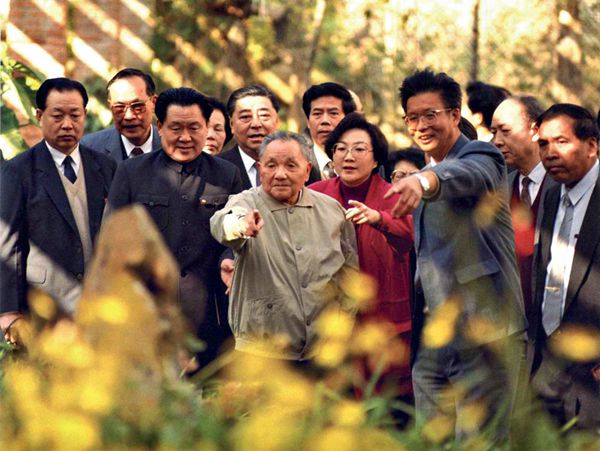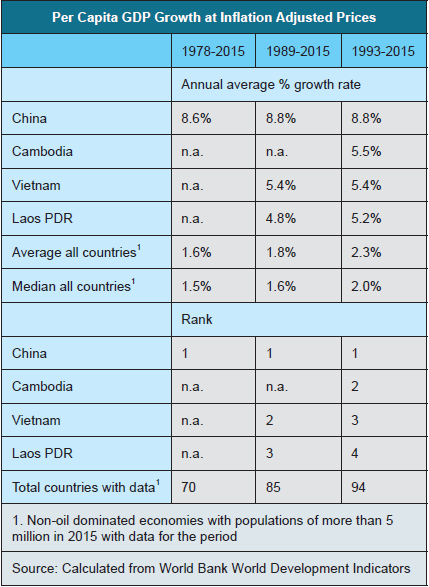By JOHN ROSS
By JOHN ROSS
THE dialogue between China and Western countries on policy for the global economy considerably deepened in 2016, but its character is changing: China’s – or more specifically the CPC’s – analysis and agenda is steadily gaining international credibility the longer the “new mediocre” in Western economies continues.
This trend in international discussions became clear at three significant events in the second half of 2016: The G20 Summit in Hangzhou on September 4-5, “The CPC in Dialogue with the World 2016” conference in Chongqing on October 13-15, and the BRICS Summit in Goa, India on October 15-16.
But these recent developments have not come out of the blue. They are the culmination of the different results of more than three decades of divergent economic strategies between China and the West, and of the superior growth results of China’s “socialist development strategy” compared to those of the World Bank/IMF Washington Consensus.
The 1978-80 Turning Point and Cumulative Trends by 2016
Both China and the Western economies almost simultaneously embarked on fundamentally new but divergent courses in 1978-80. In 1978, China commenced Deng Xiaoping’s “reform and opening-up.” In 1979-80 the West embarked on the policies which would be internationally codified in 1989 as the “Washington Consensus” with the coming to office of Thatcher and then, most importantly, Reagan. This provides the long term context for current economic discussion, as the fundamental framework of these two fundamentally different policies has continued through to the present.

In 1992, Deng Xiaoping made his second visit to Shenzhen, the first special economic zone of the country, at the age of 88.
Three and a half decades later, the balance sheet of these two economic courses is clear. China’s annual average GDP growth accelerated from less than five percent in 1950-1977 to 9.8 percent in 1978-2015. Meanwhile, U.S. growth slowed from an annual average of 3.7 percent in 1950-1980, the last year before Reagan came to office, to 2.7 percent in 1980-2015.
From 1989 to 2015 the U.S. share of world GDP at current exchange rates declined from 28 percent to 24 percent, while China’s share rose from two percent to 15 percent. By the same measure, the total share of developing economies in the world economy rose from 16 percent to 35 percent. China, from a marginal position in the global economy, had by this measure become the world’s second largest economy.
Even more dramatic are the changes measured in purchasing power parities (PPPs) which are considered by Western economic institutions to provide a better guide to long term trends in the global economy. By 2015, according to this measure, China’s economy accounted for 17 percent of the global total, making it the world’s largest economy, ahead of the U.S.’s 16 percent. Developing economies now account for the majority – 53 percent – of the world total.

Since Ronald Reagan was elected President in 1980 and the “Washington Consensus” was officially adopted in 1989, China and other developing economies have completely changed the shape of the world economy.
Indochina then India
Three neighboring countries – Vietnam, Laos, and Cambodia – were hugely influenced by China’s economic model, and their economic results were almost equally spectacular. Taking international comparisons since the putting forward of the Washington Consensus, and leaving aside very small countries with populations of less than five million, or oil producers, the four countries with the fastest-growing GDPs per capita in the world were, in descending order, China, Cambodia, Vietnam, and Laos.
China’s “socialist development model,” therefore, was once again proven in the real world to outperform by far the neo-liberal Washington Consensus. The fact that this policy yielded comparable results in countries other than China showed that it did indeed correspond, as Deng Xiaoping had stated, to universal “economic laws” and not merely to “Chinese characteristics.”
China’s success, however, and its replication by virtue of the strong economic development in Indochina, has now led to the influence of its economic strategy spreading further, indeed to a decisive country – India. The current Indian Prime Minister Modi himself, in his former position as Chief Minister of Gujurat, was a regular visitor to China. The Modi government appointed as its chief economic adviser a specialist on China’s economy – Arvind Subramanian, formerly of the Peterson Institute for International Economics, and author of Eclipse: Living in the Shadow of China’s Economic Dominance.
Key aspects of India’s new economic policies under Modi, in particular strong state infrastructure investment, a shift to a manufacturing industry, and a competitive exchange rate, are clearly based on China. The result, as in Indochina, has been spectacular growth – with India joining China as the world’s most rapidly growing major economy.

A train runs on the Ethiopia-Djibouti railway during an operational test near Addis Ababa, Ethiopia on October 3, 2016. The Chinese-built Ethiopia-Djibouti railway is hailed as the “Tazara railway for a new era.”
In addition to the decisive example of India, China’s economic policies, in particular the role of state investment, are also beginning to exert significant impact on certain African and Latin American countries. As Professor of International Political Economy at the Harvard Kennedy School Dani Rodrik noted, Ethiopia is the most astounding success story of the last decade in Africa, the annual growth of its economy having exceeded 10 percent since 2004. This was the result of a massive increase in public investment, from 5 percent of GDP in the early 1990s to 19 percent in 2011 – third highest in the world.
With regards to Latin America, Professor Rodrik observed that Bolivia is one of the rare mineral exporters that managed to avoid others’ fate in the current commodity-price downturn. This is largely to do with public investment. From 2005 to 2014, total public investment more than doubled relative to national income, from 6 percent to 13 percent.
In short, though in 1978 or 1989 very few countries internationally were seeking to learn from China’s economic policies, significant numbers now are. This much is reflected in China’s recent emergence as a clear “thought leader” in the global economy.
Forums for China’s Thought Leadership
Such growing China/CPC “thought leadership” has been expressed in different ways in various recent forums, depending on their nature.
The Hangzhou G20 Summit brought together the most powerful players in the world economy and politics – leaders of the U.S., China, the EU, Japan, and other major world powers. Although China was the G20 host, and therefore the country with the greatest ability to take initiatives and exert leadership, the G20 nevertheless cannot proceed more rapidly than at a pace to which the most powerful states within it are agreeable. This means, to be practical, that China, the U.S. and certain other states all possess effective vetoes on G20 initiatives. This simultaneously determines the powerful nature of the G20, and therefore the summit’s potential role in global economic strategy and governance, while limiting the speed of its advance.
The BRICS Summit must also proceed by consensus, with each constituent country possessing an effective veto. However, with regard to ideas and certain actions, BRICS countries are able to go further and faster than the G20 in terms of initiatives, due to the fact that four of its members are developing countries and the other, Russia, is a relatively underdeveloped advanced economy. This gives BRICS countries obvious common interests. The BRICs Summit in Goa, therefore, was abundantly clear in its highlighting of the slow growth of advanced economies, pushing forward solutions (such as infrastructure investment, attention to poverty reduction) and promoting the interests of developing countries – all of which went beyond the G20 consensus.
“The CPC in Dialogue with the World” in Chongqing had a different character. It was a meeting of representatives from more than 70 political parties and experts from more than 50 countries. As its explicit frame of reference was dialogue with the CPC it was a clear example of the ability of the CPC to play a “thought leadership” role. This, naturally, does not mean that other parties copy the CPC, and indeed it was clear from the discussion that the CPC also wanted to draw lessons from others, but more in the sense that the agenda for discussion was obviously highly influenced by the CPC. This was reflected in the numerous reports and speeches at the conference. On the Chinese side, these included Liu Yunshan, member of the Standing Committee of the Political Bureau of the CPC Central Committee; both Chongqing’s Party Secretary and Mayor; Liu Wei, president of Renmin University of China; Lin Yifu, former senior vice president of the World Bank, and many others. There were numerous foreign guests including, (and of particular significance in terms of the global economic trends already outlined) National Spokesperson on Economic Affairs for India’s BJP Gopal Krishna Agarwal.
These participants all set a framework of discussion that was complementary with, but in terms of ideas, went beyond the type of consensus that must necessarily exist at the G20. But of course the Chongqing conference was a forum for discussion, not a decision-making body.
Balance Sheet of Recent Trends
Summarizing these trends and events necessitates making a balanced assessment. There are three processes underway – in addition to that, somewhat different but interrelated, through which China has become a decisive player in global finance, with initiatives such as the AIIB. Taking overall trends:
In terms of world economic growth, countries heavily influenced by China already play a decisive role – in 2007-15, China and India alone accounted for US $8.2 trillion in GDP increases, compared to the US $3.5 trillion of the United States.
In terms of current overall weight in the world economy measured in current exchange rates, in 2015 the BRICS accounted for 22 percent of world GDP – roughly comparable to the 22 percent of the EU and 24 percent of the U.S. As regards PPPs, the BRICS has now taken a striking lead – in 2015 the U.S. accounted in PPPs for 16 percent of the world economy, and the EU 17 percent, while that of the BRICS was 31 percent of world GDP.
However, the coherence and institutional strength of the BRICS is far less not merely than the U.S., but also than the EU. As regards weight in the world economy, therefore, the advanced economic centers still dominate.
The international weight of China’s policy (and therefore the CPC’s) as earlier analyzed, has had great influence in India, which after China is the most important developing country, in Indochina, and in certain other developing countries.
But in developed countries propaganda heralding “the coming collapse of China,” the “coming crash of China,” the China “hard landing” etc., has dominated for several decades – despite the fact that none of these predictions has actually happened. Outside of “China specialists,” therefore, more objective analyses of China’s economy are only now beginning to receive the attention of a much wider circle of economists.
The Dynamics
The key point that flows from the above analysis is that it is not simply the “battle in the realm of ideas” that is determining the increasing weight of China in international economic debate.
The decisive factor is that of the proven superior growth of economies influenced by China’s socialist development strategy, as compared to those following the neo-liberal Washington Consensus. Practical economic successes are naturally much more convincing to other countries than any theoretical economic argument!
But this economic reality also determines that the international weight of the CPC’s policies is going to increase further. Owing to the policies of the Washington Consensus and the impact of Reaganomics, the Western economies are locked into low growth – around two percent.
In contrast, economies influenced by China’s economic policies are continuing to undergo much more rapid economic development. Owing to the processes outlined above, this means that the weight of the China/CPC position in the international economic discussion will continue to increase. Therefore, the balance sheet of the international discussion given above is not static, but will continue to evolve in China’s favor.
It should also be understood, however, that this development is not only in the interests of the global economy but also of China itself. The painfully slow growth of the global economy, primarily due to the snail’s pace of advanced Western economies, creates a more unfavorable context for China – in particular because it leads to slow growth of world trade and therefore slow growth of China’s exports.
The greater international influence of China’s policies will lead to a speeding-up of the global economy, and therefore be of benefit to China itself. China’s vigorous participation in the international economic discussion, therefore, is not merely in the interest of other economies, but of China itself.
JOHN ROSS is a senior research fellow at Chongyang Institute for Financial Studies, Renmin University.